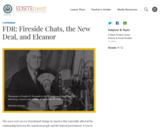
The New Deal Lesson Plans, FDR and Eleanor
- Subject:
- History
- Material Type:
- Lesson
- Provider:
- National Endowment for the Humanities
- Provider Set:
- EDSITEment!
- Date Added:
- 06/17/2021

The New Deal Lesson Plans, FDR and Eleanor
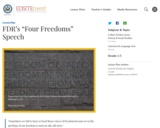
One of the most famous political speeches on freedom in the twentieth century was delivered by Franklin Delano Roosevelt in his 1941 State of the Union message to Congress. This lesson examines the rhetorical use of "freedom" with the objective of encouraging students to glimpse the broad range of hopes and aspirations that are expressed in the call of and for freedom.
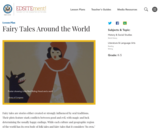
As some of the foundational texts for beginning readers, fairy tales are a staple of many classrooms. This lesson allows students to engage with fairy tales from different regions around the world and compare important cultural elements of these stories.
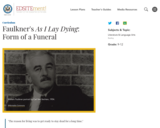
William Faulkner's self-proclaimed masterpiece, As I Lay Dying, originally published in 1930, is a fascinating exploration of the many voices found in a Southern family and community. The following curriculum unit examines the novel's use of multiple voices in its narrative.
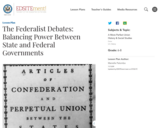
This lesson focuses on the debates among the U.S. Founders surrounding the distribution of power between states and the federal government. Students learn about the pros and cons of state sovereignty vs. federalism and have the opportunity to argue different sides of the issue.
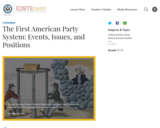
Fear of factionalism and political parties was deeply rooted in Anglo-American political culture before the American Revolution. Leaders such as George Washington and Thomas Jefferson hoped their new government, founded on the Constitution, would be motivated instead by a common intent, a unity. But political parties did form in the United States, with their beginnings in Washington's cabinet.
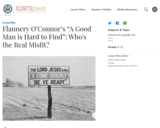
Known as both a Southern and a Catholic writer, Flannery O'Connor wrote stories that explore the complexities of these two identities. In this lesson, students will challengethese dichotomieswhile closely reading and analyzing "A Good Man is Hard to Find."
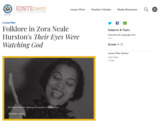
Learn how writer Zora Neale Hurston incorporated and transformed black folklife in her novel Their Eyes Were Watching God. By exploring Hurston's own life history and collection methods, listening to her WPA recordings of folksongs and folktales, and comparing transcribed folk narrative texts with the plot and themes of the novel, students will learn about the crucial role of oral folklore in Hurston's written work.
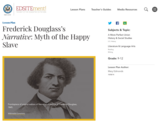
In 1845, the Narrative of the Life of Frederick Douglass, an American Slave, and Written by Himself was published. In it, Douglass criticizes directly often with withering irony those who defend slavery and those who prefer a romanticized version of it.
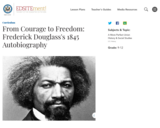
In 1845 Frederick Douglass published what was to be the first of his three autobiographies: the Narrative of the Life of Frederick Douglass, an American Slave, Written by Himself. As the title suggests, Douglass wished not only to highlight the irony that a land founded on freedom would permit slavery to exist within its midst, but also to establish that he, an American slave with no formal education, was the sole author of the work.

In the years after World War I Americans quickly reached the conclusion that their country's participation in that war had been a disastrous mistake, one which should never be repeated again. During the 1920s and 1930s"”recognized as the Interwar Period (1921-1939)"”U.S. officials pursued a number of strategies aimed at preventing war.
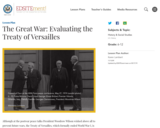
Was the Treaty of Versailles, which formally concluded World War I, a legitimate attempt by the victorious powers to prevent further conflict, or did it place an unfair burden on Germany? This lesson helps students respond to the question in an informed manner. Activities involve primary sources, maps, and other supporting documents related to the peace process and its reception by the German public and German politicians.
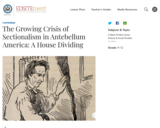
In this unit, students will trace the development of sectionalism in the United States as it was driven by the growing dependence upon, and defense of, black slavery in the southern states.
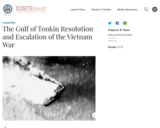
In August 1964, a small military engagement off the coast of North Vietnam helped escalate the involvement of the United States in Vietnam; the Vietnam War would become the longest military engagement in American history prior to the Iraq and Afghanistan wars.
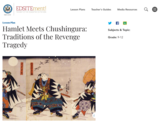
This lesson sensitizes students to the similarities and differences between cultures by comparing Shakespearean and Bunraku/Kabuki dramas. The focus of this comparison is the complex nature of revenge explored in The Tragedy of Hamlet, Prince of Denmark and Chushingura, or the Treasury of the Loyal Retainers.

This lesson plan asks students to read To Kill A Mockingbird carefully with an eye for all instances and manifestations of courage, but particularly those of moral courage.
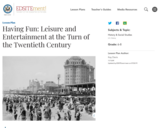
How did Americans "have fun" a century ago? In this lesson, students will learn how Americans spent their leisure time and explore new forms of entertainment that appeared at the turn of the century. In addition, they will learn how transportation and communication improvements made it possible for Americans to travel to new destinations.
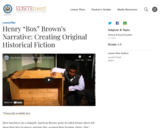
Slave narratives are a unique American literary genre in which former slaves tell about their lives in slavery and how they acquired their freedom. Henry "Box" Brown escaped from slavery by having himself shipped in a crate (hence, the nickname "Box") from Richmond, Virginia, to Philadelphia, Pennsylvania, in 1849.
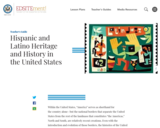
Since 1988, the U.S. Government has set aside the period from September 15 to October 15 as National Hispanic Heritage Month to honor the many contributions Hispanic Americans have made and continue to make to the United States of America. Our Teacher's Guide brings together resources created during NEH Summer Seminars and Institutes, lesson plans for K-12 classrooms, and think pieces on events and experiences across Hispanic history and heritage.
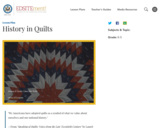
The lessons in this unit are designed to help your students recognize how people of different cultures and time periods have used cloth-based art forms (quilts) to pass down their traditions and history.